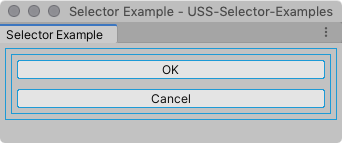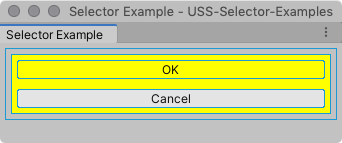Class selectors
USS class selectors match elements that have specific USS classes assigned. USS class selectors are analogous to CSS class selectors.
構文
A class selector consists of the class name prefixed with a period. Class names are case-sensitive and can’t begin with a numeral.
.className { ... }
Only use a period when you write the selector in a USS file. Don’t include it when you assign the class to an element in a UXML or C# file. For example, don’t use <Button class=".yellow" />.
In general, don’t include a period in class names. Unity’s USS parser interprets a period as the beginning of a new class. For example, if you create a class called yellow.button, and create the following USS rule: .yellow.button{...}. The parser interprets the selector as a multiple selector, and tries to find elements that match both a .yellow class and a .button class.
1 つの要素に複数のクラスが割り当てられている場合、セレクターはそのうちの 1 つだけに一致させる必要があります。
You can also specify multiple classes in a selector, in which case an element must have all of those classes assigned in order to match. See Multiple selectors for details.
例
To demonstrate how simple selectors match elements, here is an example UI Document.
<UXML xmlns="UnityEngine.UIElements">
<VisualElement name="container1">
<VisualElement name="container2" class="yellow">
<Button name="OK" class="yellow" text="OK" />
<Button name="Cancel" text="Cancel" />
</VisualElement>
</VisualElement>
</UXML>
With no styles applied, the UI looks like the following:

The following name class selector style rule matches the element container2 and the button element OK, and changes their background to yellow.
.yellow {
background-color: yellow;
}
The UI looks like the following when you apply the style:
